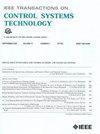带循环不等式的控制障碍函数
IF 4.9
2区 计算机科学
Q1 AUTOMATION & CONTROL SYSTEMS
引用次数: 0
摘要
控制障碍函数(CBF)与二次编程(QP)相结合,为考虑关键安全约束的控制提供了一个日益流行的框架。然而,由于与人工势场密切相关,它们存在经典的稳定假平衡点问题,即控制器可能无法将系统推向目标。本文的主要贡献在于证明了这一问题可以通过引入循环不等式作为约束条件来缓解,该约束条件迫使系统在某些条件下明确地循环障碍物。这种循环是在配置空间中引入的,一旦我们有了 CBF 约束,就可以很容易地实现,给优化问题增加的复杂度可以忽略不计。我们为这一框架提供了理论保证,表明在适当条件下,优化问题的可行性、控制输入的连续性、平衡点的特征、弱形式的 Lyapunov 稳定性以及平衡点的唯一性。所提供的实验研究展示了其整体特性和在不同情况下的适用性。本文章由计算机程序翻译,如有差异,请以英文原文为准。
Control Barrier Functions With Circulation Inequalities
Control barrier functions (CBFs) when paired with quadratic programming (QP) offer an increasingly popular framework for control considering critical safety constraints. However, being closely related to artificial potential fields, they suffer from the classical stable spurious equilibrium point problem, in which the controller can fail to drive the system to the goal. The main contribution of this article is showing that this problem can be mitigated by introducing a circulation inequality as a constraint, which forces the system to explicitly circulate obstacles under some conditions. This circulation is introduced in the configuration space and is simple to implement once we have the CBF-constraint, adding a negligible complexity to the resulting optimization problem. Theoretical guarantees are provided for this framework, indicating, under appropriate conditions, the feasibility of the resulting optimization problem, continuity of the control input, characterization of the equilibrium points, a weak form of Lyapunov stability, and uniqueness of the equilibrium points. The provided experimental studies showcase the overall properties and applicability in different scenarios.
求助全文
通过发布文献求助,成功后即可免费获取论文全文。
去求助
来源期刊

IEEE Transactions on Control Systems Technology
工程技术-工程:电子与电气
CiteScore
10.70
自引率
2.10%
发文量
218
审稿时长
6.7 months
期刊介绍:
The IEEE Transactions on Control Systems Technology publishes high quality technical papers on technological advances in control engineering. The word technology is from the Greek technologia. The modern meaning is a scientific method to achieve a practical purpose. Control Systems Technology includes all aspects of control engineering needed to implement practical control systems, from analysis and design, through simulation and hardware. A primary purpose of the IEEE Transactions on Control Systems Technology is to have an archival publication which will bridge the gap between theory and practice. Papers are published in the IEEE Transactions on Control System Technology which disclose significant new knowledge, exploratory developments, or practical applications in all aspects of technology needed to implement control systems, from analysis and design through simulation, and hardware.
 求助内容:
求助内容: 应助结果提醒方式:
应助结果提醒方式:


